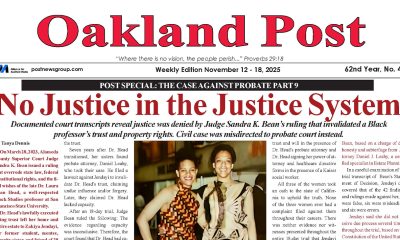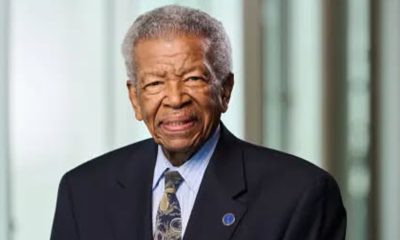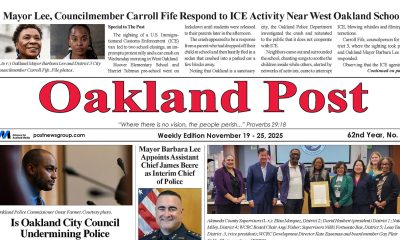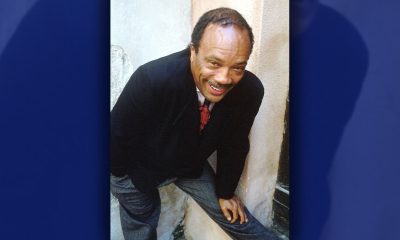Arts and Culture
In Memoriam: Former Supreme Mary Wilson Leaves Legacy of Black Pride and Resilience
Gordy expressed his sadness over Wilson’s death. “The Supremes were always known as the ‘sweethearts of Motown,’” Gordy said. “Wilson, along with Diana Ross and Florence Ballard, came to Motown in the early 1960s. After an unprecedented string of No. 1 hits, television and nightclub bookings, they opened doors for themselves, the other Motown acts, and many, many others.”

Mary Wilson, a co-founder of the best-selling girl group the Supremes, died in her sleep early Tuesday at her home in Las Vegas, Nev. She was 76.
A singer, best-selling author, motivational speaker, businesswoman, former U.S. Cultural Ambassador, mother, and grandmother, the legendary Wilson made great strides on her inevitable journey to greatness.
As an original/founding member of The Supremes, she changed the face of popular music to become a trendsetter who broke down social, racial, and gender barriers, which all started with the wild success of their first No. 1 song in 1963.
With her childhood friend Florence Ballard and lead singer Diana Ross, the Supremes achieved an unprecedented 12 No.1 hits in the mid-1960s and became international superstars by 1964 on the Motown record label, started just a few years before by Berry Gordy.
Gordy expressed his sadness over Wilson’s death. “The Supremes were always known as the ‘sweethearts of Motown,’” Gordy said. “Wilson, along with Diana Ross and Florence Ballard, came to Motown in the early 1960s. After an unprecedented string of No. 1 hits, television and nightclub bookings, they opened doors for themselves, the other Motown acts, and many, many others.”
Born in Greenville, Miss., on March 6, 1944, Wilson moved North with her family ending up in Detroit, Wis., where Berry Gordy’s Motown record label was just warming up.
She was a school friend of Ballard, who invited her to audition for the Primettes, a sister group to a boys’ trio called the Primes.
Wilson was accepted and she and Ballard would be joined by Diana Ross and Betty McGlown. By 1962, they were a trio and their first hit – “When the Lovelight Starts Shining Through His Eyes” — came the following year.
“Where Did Our Love Go?” became their first song to reach No. 1 on the pop charts and a string of hits followed making them international superstars by 1964.
With the Supremes, Wilson achieved an unprecedented 12 No.1 hits, with five of them consecutive from 1964-65. Those songs are “Where Did Our Love Go,” “Baby Love”, “Come See About Me,” “Stop! In the Name of Love,” and “Back in My Arms Again,” according to Billboard Magazine.
But all was not well. In 1967, Gordy decided to change their name to Diana Ross and the Supremes and Ballard decided to leave the group. Many years later, Wilson would express her disappointment and stick up for her friend, lobbying for a U.S. postage stamp with Ballard’s image.
“People forget that Florence Ballard not only gave us our name, but she formed the group,” Wilson revealed on “Fiyah!” a program sponsored by the Black Press of America.
“It was really Flo who formed us, and I want people to know that. I am putting together a program to get Florence Ballard a U.S. stamp, hopefully, so I want people to send their request and say something about Florence” Wilson said of her friend who died of a heart attack in 1976. “All those hits were Florence, so when you are listening to [The Supremes], it’s about Flo, so I want people who listen to those songs that bring back memories, think about Flo.”
Ballard was replaced by Cindy Birdsong and the group continued to perform until 1970 when Ross would leave the group for a solo career in 1970. The group continued to have hits like “Stoned Love” in 1970.
By the mid-1970s, Wilson was doing half of the Supremes’ lead vocals but she left the group in 1977.
Nearly a decade later, Wilson found success in writing her memoirs: “Dreamgirl: My Life as a Supreme,” in 1986 and “Supreme Faith: Someday We’ll Be Together” in 1990.
She became a frequent guest on TV talk shows and performed regularly in Las Vegas casinos and resorts.
Colin Powell named her a cross-cultural ambassador in 2002 and she appeared at events sponsored by the State Dept.
Wilson released CDs in 2006 and 2010, while also becoming a musical activist, going to court to prevent impostors from performing under the names of groups from the 1950s and ‘60s, including the Motown group the Marvelettes as well as the Supremes. The law was passed in 27 states.
She lectured all over the world giving advice on reaching goals and triumphing over adversity and became known for her charity work with the American Cancers Society, St. Jude’s Children’s Research Hospital and the NAACP among others, including the Figure Skaters of Harlem, which encourages youth gain entry to the Olympics.
In 2019, Wilson appeared in a “Dancing With the Stars” segment and published “Supreme Glamour,” an appreciation of the fashion the Supremes wore on stage. A collection of the gowns has been on exhibit at the Rock & Roll Hall of Fame in Cleveland, Ohio, since 2008.
With the Supremes, Wilson was inducted into the National Rhythm and Blues Hall of Fame in 2013 and received a lifetime Achievement Award from the National Newspaper Publishers Association in 2020.
Wilson married Pedro Ferrer in 1974 and the couple had three children: Turkessa, Pedro Antonio and Rafael. She and Ferrer divorced in 1981. In 1994, Rafael was killed in a car accident.
“Ms. Wilson used her fame and flair to promote a diversity of humanitarian efforts, including ending hunger, raising HIV/AIDS awareness, and encouraging world peace. Mary was working on getting a U.S. postage stamp of her fellow bandmate and original Supreme Florence Ballard who passed away in 1976,” longtime publicist and friend Jay Schwartz said.
She was working on new projects for 2021, including an album she recently teased on her YouTube channel. Her primary love was preserving the legacy of the Supremes and introducing her music to new generations.
“I think that The Supremes had a lot to do with the awakening of the world in terms of what blackness was,” Wilson said in her 2020 NNPA interview. “The whole world was watching Black people in a way they’d never seen.”
Wikipedia, Stacy Brown/NNPA contributed to this report.
Activism
Essay: Intentional Self Care and Community Connections Can Improve Our Wellbeing
At the deepest and also most expansive level of reality, we are all part of the same being, our bodies made from the minerals of the earth, our spirits infused by the spiritual breath that animates the universe. Willingness to move more deeply into fear and pain is the first step toward moving into a larger consciousness. Willingness to move beyond the delusion of our separateness can show us new ways of working and living together.

By Dr. Lorraine Bonner, Special to California Black Media Partners
I went to a medical school that was steeped in the principles of classical Western medicine. However, I also learned mindfulness meditation during that time, which opened me to the multifaceted relationship between illnesses and the interconnecting environmental, mental and emotional realities that can impact an individual’s health.
Therefore, when I began to practice medicine, I also pursued training in hypnosis, relaxation techniques, meditation, and guided imagery, to bring a mind-body focus to my work in medical care and prevention.
The people I saw in my practice had a mix of problems, including high blood pressure, diabetes, and a variety of pain issues. I taught almost everyone relaxation breathing and made some general relaxation tapes. To anyone willing, I offered guided imagery.
“My work embraced an approach to wellness I call “Liberatory Health” — one that not only addresses the treatment and management of disease symptoms but also seeks to dismantle the conditions that make people sick in the first place.”
From my perspective, illness is only the outermost manifestation of our efforts to cope, often fueled by addictions such as sugar, tobacco, or alcohol, shackled by an individualistic cult belief that we have only ourselves to blame for our suffering.
At the deepest and also most expansive level of reality, we are all part of the same being, our bodies made from the minerals of the earth, our spirits infused by the spiritual breath that animates the universe. Willingness to move more deeply into fear and pain is the first step toward moving into a larger consciousness. Willingness to move beyond the delusion of our separateness can show us new ways of working and living together.
To put these ideas into practical form, I would quote the immortal Mr. Rogers: “Find the helpers.” There are already people in every community working for liberation. Some of them are running for office, others are giving food to those who need it. Some are volunteering in schools, libraries or hospitals. Some are studying liberation movements, or are working in urban or community gardens, or learning to practice restorative and transformative justice, or creating liberation art, music, dance, theater or writing. Some are mentoring high schoolers or apprenticing young people in a trade. There are many places where compassionate humans are finding other humans and working together for a better world.
A more compassionate world is possible, one in which we will all enjoy better health. Creating it will make us healthier, too.
In community, we are strong. Recognizing denial and overcoming the fragmenting effects of spiritual disorder offer us a path to liberation and true health.
Good health and well-being are the collective rights of all people!
About the Author
Dr. Lorraine Bonner is a retired physician. She is also a sculptor who works in clay, exploring issues of trust, trustworthiness and exploitation, as well as visions of a better world.
Activism
A Call to Save Liberty Hall: Oakland’s Beacon of Black Heritage Faces an Uncertain Future
For generations, Liberty Hall has been more than bricks and wood — it has been a spiritual and cultural sanctuary for Black Oakland. The building once served as a hub for Marcus Garvey’s Universal Negro Improvement Association (UNIA), where Garvey’s call for economic independence and Pan-African unity resonated through the hearts of a people newly migrating to the West in search of freedom and dignity.

Special to The Post
On a quiet corner near the West Oakland BART Station stands a weathered but proud monument to African American history — the Universal Negro Improvement Association’s Liberty Hall, also known as the Marcus Garvey Building. Built in 1877, this two-story Italianate landmark has witnessed more than a century of struggle, self-determination, and community empowerment. Now, its survival hangs in the balance.
For generations, Liberty Hall has been more than bricks and wood — it has been a spiritual and cultural sanctuary for Black Oakland. The building once served as a hub for Marcus Garvey’s Universal Negro Improvement Association (UNIA), where Garvey’s call for economic independence and Pan-African unity resonated through the hearts of a people newly migrating to the West in search of freedom and dignity.
Local 188 of UNIA was the largest chapter in Northern California when the organization bought the building in 1925, but a fire burned the roof in 1931, and the chapter sold the building in 1933. The International Peace Movement, founded by Father Divine, used the building through the 1950s.
Since then, the building has been a meeting ground for civil rights organizers, artists, and educators like Overcomers With Hope who have carried that same flame of liberation through Oakland’s turbulent decades.
Today, local cultural organizer and artist Douglas “Pharoah” Stewart has stepped forward to lead the charge to save Liberty Hall. Stewart is already facing “Cultural Eviction” at the Oakland Cannery, and through his organization, Indigenous House, Stewart has rallied a coalition of artists, educators, historians, and community leaders to preserve and restore the site as a community-owned cooperative center — a place where arts, wellness, and economic empowerment can thrive for future generations.
“Liberty Hall is not just a building — it’s a living ancestor,” Stewart says. “This space gave birth to movements that shaped who we are as a people. If we lose this, we lose a piece of our soul.”
Stewart envisions transforming the historic landmark into a multi-purpose cooperative hub — complete with a cultural museum, community performance space, youth tech labs, and creative studios for local entrepreneurs. His vision echoes Garvey’s own: “A place where we can rise together, economically, spiritually, and culturally.”
But the fight is urgent. The aging building faces structural challenges, and time is running short to secure preservation funding. Stewart and his team are now calling on city officials, foundations, athletes, and celebrities to join forces with the community to raise the necessary capital for acquisition and restoration.
“We’re inviting everyone — from the Oakland A’s to local artists, from Golden State Warriors players to Black-owned businesses — to stand with us,” Stewart urges. “Let’s make Liberty Hall a model for what preservation can look like when the people lead.”
The Liberty Hall Project aligns with Oakland’s growing movement to protect historic Black cultural sites — places like Esther’s Orbit Room, Marcus Bookstore, and the California Hotel. For Stewart, Liberty Hall represents a chance to bridge the city’s past with its future, transforming preservation into a living, breathing act of justice.
“This is not nostalgia,” Stewart says. “This is nation-building. It’s about creating sustainable, community-owned spaces that honor our ancestors and empower our youth.”
As development pressures mount across West Oakland, Liberty Hall stands as a powerful reminder of resilience, resistance, and rebirth. The question now is whether the community — and those with the power to help — will answer the call.
For donations, partnerships, or information about the Liberty Hall Cooperative Development Project, contact Indigenous House at www.indigenoushouse.org Douglas Stewart dstewart.wealth@gmail.com
Activism
MLK Way at 57th Street in Oakland Renamed Bobby Seale Way for Black Panther Co-Founder
In 1962, Bobby Seale and Virtual Murrell cofounded the first known Black student organization called the Soul Students Advisory Council at Oakland City College located at 57th and Grove streets, now MLK. Jr. Way.

By Zac Unger
We are so proud to honor the legacy of the great Bobby Seale by commemoratively renaming 57th Street and Martin Luther King Jr. Way to Bobby Seale Way in North Oakland. Seale, 88, has dedicated his life to advancing social justice, racial equality, and community self-determination. He played an essential part in the history of our country by co-founding the Black Panther Party for Self Defense in Oakland in 1966 with the late Huey Newton.
Our City has a tremendous history of activism, and it is a legacy we are proud of and strive to continue as our community and country face so many incredible challenges right now.
In 1962, Bobby Seale and Virtual Murrell cofounded the first known Black student organization called the Soul Students Advisory Council at Oakland City College, located at 57th and Grove streets, now MLK. Jr. Way.
Later, they cofounded the first Negro history class, which led to the establishment of the first Black Studies program in college curricula in the country. Murrell is scheduled to introduce Seale at the street dedication.
The author of “Seize the Time,” Seale ran for mayor of Oakland in 1973, coming in second in a field of nine. We are proud to memorialize his legacy by renaming this street so that we do not forget the legacy and change he has made.
Zac Unger is Oakland’s District 1 Councilmember
-

 Activism4 weeks ago
Activism4 weeks agoOakland Post: Week of November 12 – 18, 2025
-

 Activism3 weeks ago
Activism3 weeks agoIN MEMORIAM: William ‘Bill’ Patterson, 94
-

 Activism4 weeks ago
Activism4 weeks agoHow Charles R. Drew University Navigated More Than $20 Million in Fed Cuts – Still Prioritizing Students and Community Health
-

 Bay Area4 weeks ago
Bay Area4 weeks agoNo Justice in the Justice System
-

 #NNPA BlackPress3 weeks ago
#NNPA BlackPress3 weeks agoBeyoncé and Jay-Z make rare public appearance with Lewis Hamilton at Las Vegas Grand Prix
-

 #NNPA BlackPress3 weeks ago
#NNPA BlackPress3 weeks agoLewis Hamilton set to start LAST in Saturday Night’s Las Vegas Grand Prix
-

 Activism3 weeks ago
Activism3 weeks agoOakland Post: Week of November 19 – 25, 2025
-

 #NNPA BlackPress4 weeks ago
#NNPA BlackPress4 weeks agoThe Perfumed Hand of Hypocrisy: Trump Hosted Former Terror Suspect While America Condemns a Muslim Mayor




















































